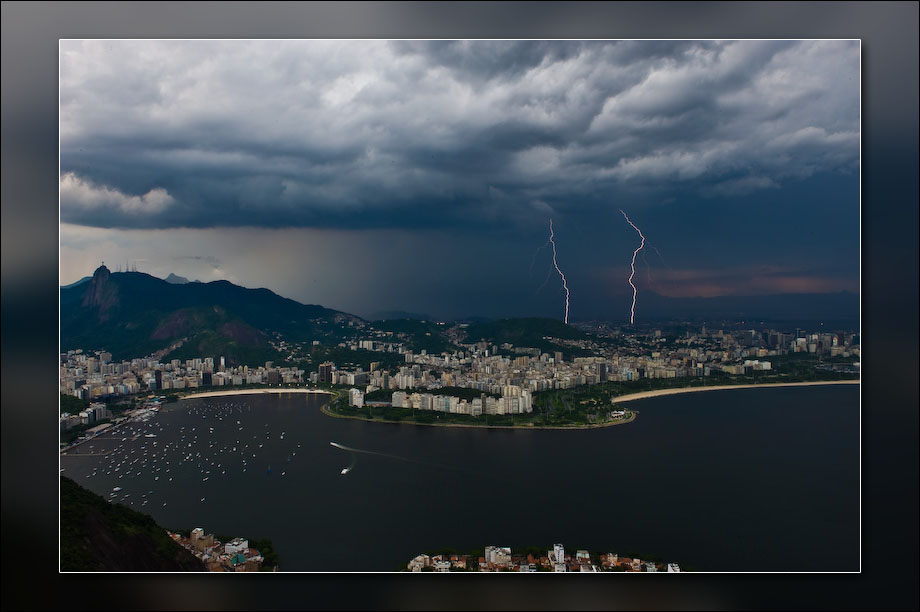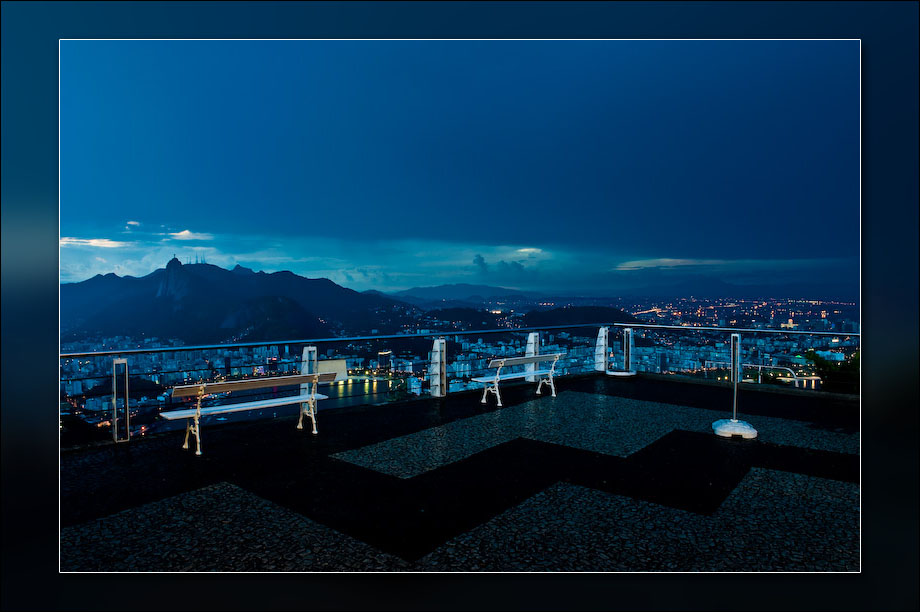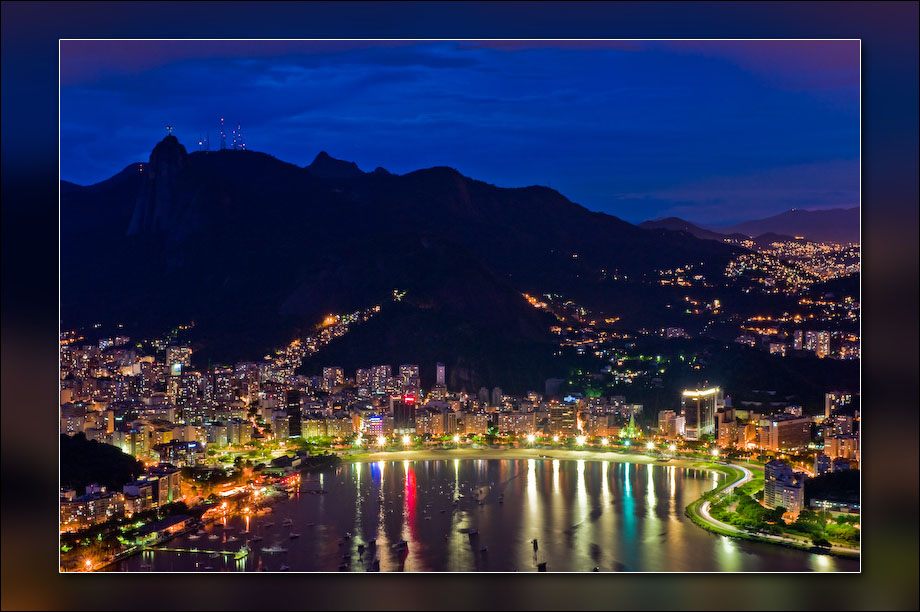I can't count the times I've been warned not to take expensive camera gear on my trip. And Rio is the worst. Even after arriving, one of my hostel roommates told me about another traveler who took his camera to the beach only days earlier and had to give it up at gunpoint.
I was thinking about hiring a cop to walk with me. I figured he would be a good deterrent and I know he could use the extra money. But I would have to track one down who would be willing and it can be a nuisance having someone with me when I'm wandering around shooting. I'm not sure what I'm going to do, but there has to be some way to take a photo in Rio without getting mugged.
 0730. My alarm goes off. I lie in bed a little while, thinking, wondering, strategizing. I get up and grab a shower. I can't figure out how to get hot water, so I wash as quickly as practicable, gasping for air as I rinse the soap out of my hair. Back into the room, organize my stuff a bit, put my expensive camera gear that I won't be taking and my laptop in my large backpack, then install the pacsafe 85 around it and lock it to the bed to keep common thieves out and to encourage them to walk off with someone else's stuff instead.
0730. My alarm goes off. I lie in bed a little while, thinking, wondering, strategizing. I get up and grab a shower. I can't figure out how to get hot water, so I wash as quickly as practicable, gasping for air as I rinse the soap out of my hair. Back into the room, organize my stuff a bit, put my expensive camera gear that I won't be taking and my laptop in my large backpack, then install the pacsafe 85 around it and lock it to the bed to keep common thieves out and to encourage them to walk off with someone else's stuff instead.
I grab some breakfast downstairs, a ham and cheese sandwich and a few slices of watermelon. I eat outside in the narrow corridor leading into the hostel from the street, sitting on a bench next to another traveler. We eat in silence. I don't know what she's thinking, but I'm still pondering my move.
Back upstairs, I keep looking out the window, still fearing this immense city. I take a few pictures out the window, stalling. Do I just take my point and shoot camera? Would a crook not be interested in that? Maybe not, but then I wouldn't get the shots I want. I own an high-end camera for a reason. If I do my part, it always gets the shot.
To heck with it. I put some SPF50 on and throw my sling pack over my shoulder. It contains my Nikon D3 and has the Nikkor 24-70 f/2.8 lens attached to it—a general purpose combo that can shoot anything this world can throw at it, in any environment. The trick is to arrive back at the hostel later in the day with everything I'm leaving with—including my life. I head out.
A sling pack is the perfect pack for this kind of shooting. It rides on your back, like any pack, but you give it a tug and it slides around front. You remove your camera, shoot, put the camera back, and slide it back around to the rear. I can accomplish this sequence in probably less than 15 seconds, at least if I don't dawdle while shooting. That's the plan. Run 'n' gun. Get the shot and put the camera away. Give the bad guys as little time as possible to see the goods.
As I leave the hostel, I pull out my map to get my bearings and decide which direction I'm going to head. I'll take two quick rights out of the hostel and then head West on Rua Voluntarios De Patria. When that tees into Rua Humaita, I'll veer left. When I run into Lagoa Rodrigo de Freitas, a big lake inland from the major beaches, I'll amber along its eastern shore, then cut over to Ipanema beach, and take that back towards Botafogo, the area where I'm staying.
 I head out of the hostel into the city. The density of people in Rio seems high and there's a corresponding level of activity. There are always people on the street—loads of vendors, approximately three trillion storefronts (I'm not exaggerating), mothers carrying babies, pushing strollers, and leading children by the hand, businessmen going to work, and blue collar workers pushing and pulling steel carts down the road.
I head out of the hostel into the city. The density of people in Rio seems high and there's a corresponding level of activity. There are always people on the street—loads of vendors, approximately three trillion storefronts (I'm not exaggerating), mothers carrying babies, pushing strollers, and leading children by the hand, businessmen going to work, and blue collar workers pushing and pulling steel carts down the road.
The pushing and pulling of carts in the streets is significant because the traffic here is fast and heavy. Many small cars are constantly zipping by with seemingly little regard for pedestrians. Likewise, pedestrians cross at crosswalks—and anywhere else they please—in between oncoming traffic. It appears rather dangerous, but autos and pedestrians seem to weave through each other with deft and precision, all participants coming out unscathed. I dig it and try it myself a few times. I enjoy the precision of the intertwining objects, like the cogs of many meshing gears.
As I begin my walk, I start scanning for interesting photographic opportunities. They begin to appear immediately. I decide to pass one up, figuring I'll get it later. There's the fear people have been foisting on me. I go back, swing my pack around, unzip the pouch, pull the heavy camera and lens from the bag, point, shoot, replace the camera, zip up the pocket, and swing the pack back around onto my back. I'll repeat this procedure almost two-hundred times over the next eight hours.
I see many people hurrying to their destination, while others casually sit at an open storefront sipping a coffee or drinking a fruit juice. Others are shopping or working.
I see a bum—er, homeless man—who looks very interesting. He is wearing what looks like a skirt with slits running almost the entire length. His hair is in dreadlocks and he is clearly a descendent of the myriad African slaves who were brought across the Atlantic centuries ago to this brave new world. Brazil has the second largest population of blacks in the world, second only to Nigeria. I want to get a photo of him, but the opportunity doesn't present itself.
He and I are both strolling in the same direction. Every so often, I stop to snap a photo. He's behind me now. I wonder if he's following me. I regularly check my back for anyone who looks suspicious. Someone who might have seen my camera and is biding their time, waiting for a spot with fewer people so they can pull a knife or gun and demand my bag. So far, so good. No one tailing me, except for the bum—er, homeless man.
I pick up the pace, hoping to lose him, or that he'll turn onto some other street, or find a good spot at which to beg. I must be busy shooting because he catches up with me. I let him pass me so I can keep and eye on him. Surprisingly, he stops, sits down on the curb, and makes himself comfortable. He's drinking a cup of coffee—perhaps a kind gesture from someone more fortunate than he.
 In an instant, I see it. The perfect shot. Within a couple seconds, I have the camera out and to my eye. I kneel and peer through the D3's big, bright viewfinder. I wait a second, then snap. Got it. Stand up, camera back in the bag, move on.
In an instant, I see it. The perfect shot. Within a couple seconds, I have the camera out and to my eye. I kneel and peer through the D3's big, bright viewfinder. I wait a second, then snap. Got it. Stand up, camera back in the bag, move on.
I come to the first tee and am not certain if I'm in the right place, as the intersection is somewhat complex. I pull out my map of Rio and get my bearings. This is it. I turn toward Lagoa Rodrigo de Freitas. I continue my trek and arrive at the lake before long.
What a beautiful sight. Behind me is a mountain of rock, Morro de Formiga, perhaps, the mountain on which was built the famous and rather enormous statue Christo Redentor, its top currently obscured by the late morning clouds. I'm learning that you can get an idea where you are within the city by looking for a big rock whose shape you can identify. Across the lake are more hills and to my left, south of my location, is a particularly large rock, which sits between the lake and Ipanema.
 There are many cyclists and joggers exercising here, using the lake as a big track, as there is a concrete path circumscribing it. I amble along its East side, shooting some scenics across it toward Rocinha, the largest favela in Brazil. Most of the favela is not visible from this side of the hill, but some houses spill over the peak in my direction, a welcome addition to the photo. The bulk of this giant slum is located on the West side of the hill. Any place where the hills are not too steep, people from the outlying areas have moved in to get closer to the city, building illegal cities with great views of Rio and the Atlantic ocean.
There are many cyclists and joggers exercising here, using the lake as a big track, as there is a concrete path circumscribing it. I amble along its East side, shooting some scenics across it toward Rocinha, the largest favela in Brazil. Most of the favela is not visible from this side of the hill, but some houses spill over the peak in my direction, a welcome addition to the photo. The bulk of this giant slum is located on the West side of the hill. Any place where the hills are not too steep, people from the outlying areas have moved in to get closer to the city, building illegal cities with great views of Rio and the Atlantic ocean.
By now, it's a bit hot and humid, at least more so than the previous day, which was mostly cloudy. I could use a drink. Thankfully, there are street vendors all over the place with a cooler full of coconuts. You pay them about a buck-fifty, they pull out the coconut, and start swinging at it with a cleaver using very aggressive blows. I wouldn't dare try it, lest I come home with fewer digits than I was born with. He chops off one end which will form a stable base on which the coconut will stand, then does the same to the other, before cutting a hole for the straw with three quick strikes.
 The juice is cold and refreshing. I sit and watch cyclists and runners stay—or get—in shape. I'm in the shade and am enjoying the peace and serenity of the lake. After I finish the juice, I hand the coconut back to the street vendor and he splits the shell into three pieces. One will act as a bowl for the meat. He takes the meat from the other two pieces and places it in the newly created container. Neither the juice nor the meat is particularly tasty, but I appreciate the juice in particular because it is cool.
The juice is cold and refreshing. I sit and watch cyclists and runners stay—or get—in shape. I'm in the shade and am enjoying the peace and serenity of the lake. After I finish the juice, I hand the coconut back to the street vendor and he splits the shell into three pieces. One will act as a bowl for the meat. He takes the meat from the other two pieces and places it in the newly created container. Neither the juice nor the meat is particularly tasty, but I appreciate the juice in particular because it is cool.
 At one point as I'm sitting in one of several white plastic chairs, then vendor walks over to me, picks up my camera bag off the ground, places it in the chair next to me, and turns that chair to face me. I had taken a photo of him as he prepared my coconut meat and he must be concerned for the safety of my bag. Definitely a kind and considerate fellow.
At one point as I'm sitting in one of several white plastic chairs, then vendor walks over to me, picks up my camera bag off the ground, places it in the chair next to me, and turns that chair to face me. I had taken a photo of him as he prepared my coconut meat and he must be concerned for the safety of my bag. Definitely a kind and considerate fellow.
From here I make my way South toward Ipanema. I'm not sure how to break through to the beach. There's a mountain in the way—Morro de Cantagalo. I decide to go the longer route. I stay on the lake perimeter a bit longer, then find the first crosswalk. There I head toward the beach through several busy city blocks. On the way, I pass the restaurant made famous by the song Girl from Ipanema—Veloso, now renamed Garota de Ipanema.
The day is nice, and, although it's a weekday during business hours, there's a surprising number of people at the beach, crowded in places, and sparser in others. As I head East toward Copacabana, I continue my routine. Look for a good shot, pull out the camera, snap, put the camera away. The beaches here are enormously wide—a few hundred yards, I would say.
Between Ipanema and Copacabana is a large rock peninsula. I walk out onto it and take in a great view overlooking both beaches. Suddenly, out of nowhere, comes in a chopper, low and fast. It banks steeply around the peninsula and comes pretty close. Probably a tour flight. Very cool.
 After heading back to the main drag, I continue on down to Copacabana. There is a wider and nicer walkway along this beach. It's one I've seen in photos and have looked forward to photographing, myself. Partway down this beach, I realize I'm hungry and decide to pull into the first beachfront restaurant I see. I ask the Carioca that greets me what she would recommend. She points at the Caipirinha and Parisian Salad and Italian Shrimp.
After heading back to the main drag, I continue on down to Copacabana. There is a wider and nicer walkway along this beach. It's one I've seen in photos and have looked forward to photographing, myself. Partway down this beach, I realize I'm hungry and decide to pull into the first beachfront restaurant I see. I ask the Carioca that greets me what she would recommend. She points at the Caipirinha and Parisian Salad and Italian Shrimp.
As I sit and enjoy my meal while looking out over the beach—and relaxing in the shade—two gals sit down at the table next to me, staring blankly at their menus. After a while, the waitress brings out another set of menus and the two girls breathe a collective sigh of relief. The new menus are in English. Lisa is from Canada and Carina Australia. We have a very pleasant chat, then go our separate ways.
 I polish off Copacabana fairly quickly, then turn towards Botafogo, where I'm staying. I notice my calves are hurting, not from walking, but because I failed to grease them up with sunscreen before I left the hostel. I also missed the sides of my neck, the backs of my arms, and my upper chest. Could've been much worse. At least I got most key areas.
I polish off Copacabana fairly quickly, then turn towards Botafogo, where I'm staying. I notice my calves are hurting, not from walking, but because I failed to grease them up with sunscreen before I left the hostel. I also missed the sides of my neck, the backs of my arms, and my upper chest. Could've been much worse. At least I got most key areas.
I'm hoping to pass by a cemetery I passed on the way to the hostel from the airport, but I can't find it. I'll ask its location when I get back to the hostel and go there another day. I'm a little lost, but don't mind asking directions. The only problem is that I don't speak Portuguese and many Brazilians don't speak English. Eventually, I find the neighborhood where the hostel is located. I circle the block once, honing in on the proper street.
After getting back, I can't help but brag to a few other travelers that I still have my camera gear. It wasn't so bad. I watched my back and kept the camera exposed as little as possible.
One challenge down, a hundred to go.
For more photos of Rio, go here. A lot more will be coming.





























